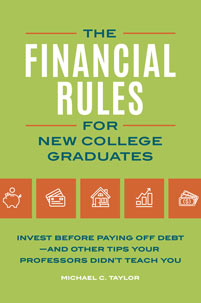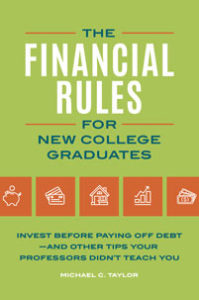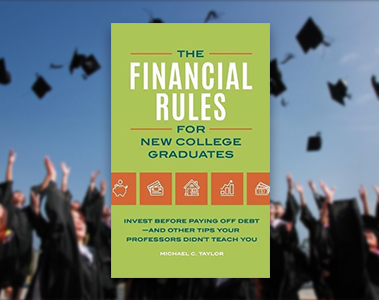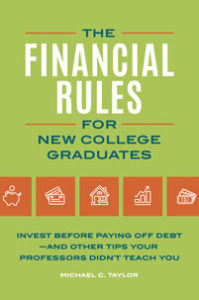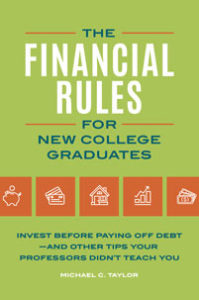Editor’s Note: This post first appeared in Make Change magazine, an online personal finance site with a social conscience.
I don’t believe it’s an actual conspiracy of silence to keep us in the dark about our finances, but sometimes it feels that way to me. That’s partly why I wrote The Financial Rules For New College Graduates, because I’m convinced that learning how to do some not-too-sophisticated math in a spreadsheet could go a long way toward demystifying finance for the non-finance professional.
The skill of discounting cashflows is the fundamental tool of all investing. It answers important questions like:
- What is the value of a bond with known interest and principal payments?
- What is the fundamental value of a stock, based on a model of future projections of profit?
- What is the value of an annuity?
- What is the cost, in today’s dollars, of future government obligations like Social Security and Medicare?
- What is the right choice for a retiree to make, choosing between and lifetime pension and a lump sum?
- What is the right choice for a lottery winner, between annual payments and a lump sum? 1
You may not want to always do the math on these questions, but if you learn how it works you have a much better shot at pulling back the curtain on supposedly complex financial mysteries.
Watch this first video, for example, to see how we would build a discounting cashflow calculator in a spreadsheet.
Learning the math
It’s not hard, and if you’ve learned compound interest, then it’s kind of a snap. See for example earlier posts on Be a Compound Interest Wizard Part I, and Be a Compound Interest Wizard Part 2.
But it does involve math and poking around with a spreadsheet.
[Begin Book Excerpt]
So what is it?
Discounting cash flows – in the simplest mathematical sense – is just the opposite action to compound interest.
Specifically, the discounting cash flows formula tells us how a certain known amount of money in the future (FV) can be ‘discounted’ back to a certain known amount in the present (FV) through the intervention of an interest rate (Y) and multiple compounding periods (N).
Notice that we use the exact same variables in both formulas. Notice, also, that the only difference mathematically is that we’re solving for a different number.
The discounted cashflow formula simply reverses the algebra of the compound interest formula.
The discounted cashflow formula solves for Present Value, so that:
PV = FV / (1+Y)^N
So why do we care about discounting cashflow?
A simplified example should help to get us started.
A builder’s insurance company offers you a $25,000 lump sum payment to compensate you for the pain and hardship of an injured pet hit by an errant beam that fell from his construction site.
Picture a big piece of wood, it hurt the dog’s paw, the dog will likely make a full recovery, but the developer/builder offered you this settlement to avoid a costly lawsuit with bad public-relations potential.
Importantly, however, the settlement will be paid out 10 years from now. Note, by the way, that this is common practice in injury-settlement cases. Lump sums get offered far into the future. This is partly because such agreements incentivize the victim/beneficiary to comply with the terms of the settlement for the longest period of time. But also importantly, as we will see, it’s much cheaper for the insurance company to make payments deep into the future.
Now, back to the math.
Let’s assume the insurance company is a very safe, stable, company, and we expect moderate inflation, so the proper Y, or discount rate for the next 10 years, is around 3%.
How much is that settlement worth to us today?
Let’s go to the spreadsheet.
We set up our formula in a spreadsheet that the value today, or Present Value (PV) is equal to FV/ (1+Y)^N.
We know the future payout, FV, is $25,000.
We know how many years we have to wait, so N is 10.
We’ve assumed a Y of 3%.
The present value will be equal to $25,000/ (1+3%)^10.
This is easy-peasy math for your spreadsheet, which tells us the present value is $18,602.
What does this mean in practice? We’re not going to ‘invest’ $18,602 in this future $25,000 insurance payout, but it can be very helpful for us to understand that the future $25,000 payment really only costs the insurance company about 75% of what it first appears to cost
By the way, how did I come up with 3%?
Frankly and honestly, I made up the 3% for the example.
I don’t just say ‘I made it up’ to be flippant. I mean to emphasize that ‘I made it up’ because ‘making up’ Y, or the proper yield or discount rate (remember, those mean the same thing!) is a key to effectively using the discounted cash flows formula.
In fact, any time you discount cash flows, you have to “make up,” or assume, a certain Y or discount rate, and the Y assumption you use is as much art as science.
Is that 3% Y I assumed “correct?”
I don’t know, but it’s reasonable, and that’s usually the most we can say about any assumed Y. How do we come up with a reasonable Y number?
Y as an interest rate or discount rate (remember: same thing!) reflects a combination of
- a) the market cost of money, which is often called an ‘interest rate,’
- b) the expectation of inflation in the future, and
- c) the risk of the payment actually being made in the future.
Only some of these things can be known at any time, so only some of our Y is scientifically knowable. The rest has to be assumed according to best estimates. That’s why we can reasonably say that sometimes this Y assumption is as much art as science.
[End book excerpt]
If you want to take it to the next level of how discounting cashflows is used in practice among investment professionals, you could set up your spreadsheet to discount a series of cashflows. Setting up formulas to discount a whole series of cashflows is how we build a model for valuing bonds, for example, or fundamental pricing of stocks.
This video explains the basics for setting up a series of discounting cashflows.
If you decide later become a complete discounting cashflows ninja, you’d then want to layer in one more additional level of complexity, by discounting cashflows that happen more than once a year. A simple video introducing how to deal with that is here:
The last thing I would say about this is that while you don’t have to learn this math in order to manage your money right, I think its useful to know what the Wizards of Wall Street are up to. If you understand their tools, you’re more likely to ask a financial guru a hard question, like:
“Um, why do charge so much, when this doesn’t seem that complex?”
Post read (231) times.
- Important personal finance PSA: Never Play The Lottery! ↩

